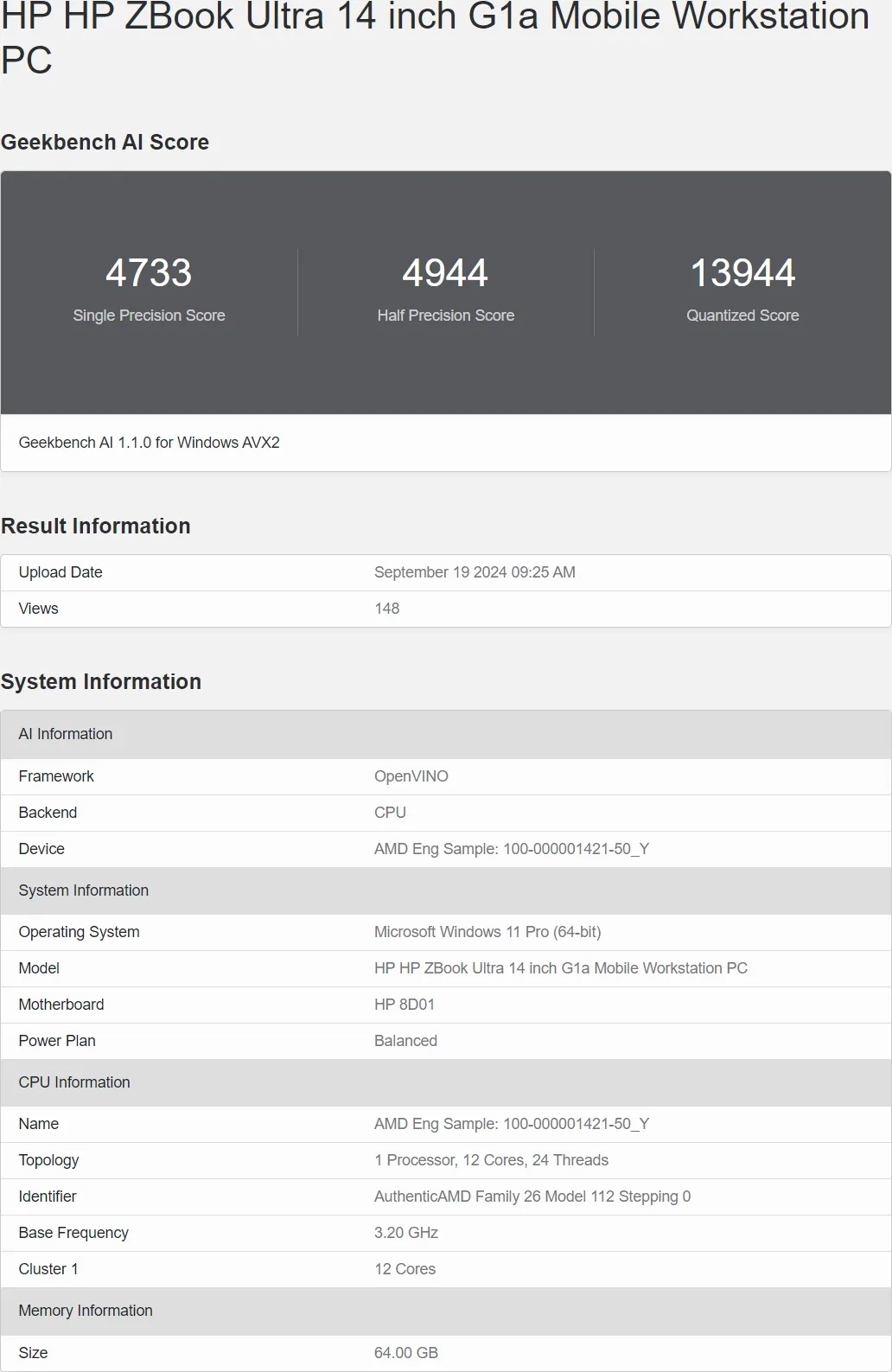AMD Ryzen AI Max “Strix Halo” Appears on Geekbench with Promising AI Performance
AMD’s upcoming Strix Halo “Ryzen AI Max” APU has been spotted on Geekbench, giving us the first look at its AI and compute capabilities. Discovered by @Olrak2_, the engineering sample was identified as “AuthenticAMD Family 26 Model 112 Stepping 0” and tested on an HP ZBook Ultra 14-inch G1a mobile workstation.
In Geekbench’s AI benchmarks, the chip scored:
- 4733 points in single-precision (FP32) tests
- 4944 points in half-precision (FP16) tests
- 13,944 points in quantization workloads
While scores may vary by device, these early results highlight the AI acceleration potential of Strix Halo.
Ryzen AI Max vs Ryzen AI 9 HX 370 #
Compared to the existing Ryzen AI 9 HX 370, Strix Halo demonstrates major improvements:
- Base clock: 3.2 GHz (+1.2 GHz higher than HX 370)
- Core/thread config: Both offer 12 cores / 24 threads
- Integrated GPU: Strix Halo packs 40 RDNA 3.5 compute units, compared to just 12 CUs in HX 370
This means Strix Halo will deliver dramatically stronger graphics performance alongside faster compute capabilities.

Expected Features of AMD Ryzen AI Max “Strix Halo” #
Based on leaked specifications, the Ryzen AI Max Strix Halo lineup will include:
- Zen 5 CPU cores (up to 16 cores / 32 threads)
- 64 MB shared L3 cache
- 40 RDNA 3+ compute units for the iGPU
- 32 MB MALL cache (dedicated to graphics)
- 256-bit LPDDR5X-8000 memory controller
- Integrated XDNA 2 AI engine
- Up to 60 AI TOPS performance
- 16 PCIe Gen4 lanes
- Power range: 55W–130W (FP11 platform)
- Expected launch: late 2024 / early 2025

Strix Halo Lineup and Market Position #
The Ryzen AI Max 300 series is designed to deliver desktop-class performance in mobile form factors, reducing the need for dedicated GPUs in many workloads.
Here’s a quick specs comparison:
| Model | CPU Cores / Threads | Base Clock | iGPU Compute Units | L3 Cache | AI Engine | Memory Support | TDP Range |
|---|---|---|---|---|---|---|---|
| Ryzen AI 9 HX 370 | 12C / 24T (Zen 5) | 2.0 GHz | 12 RDNA 3 CUs | 32 MB | XDNA (early gen) | LPDDR5X-7500 | 45–65W |
| Ryzen AI Max 390 | 12C / 24T (Zen 5) | 3.2 GHz | 40 RDNA 3.5 CUs | 64 MB | XDNA 2 | LPDDR5X-8000 | 55–130W |
| Ryzen AI Max+ 395 | 16C / 32T (Zen 5) | 3.2+ GHz | 40 RDNA 3.5 CUs | 64 MB | XDNA 2 | LPDDR5X-8000 | 55–130W |
Gaming Performance Outlook 🎮 #
While Geekbench provides useful compute benchmarks, gamers are most interested in real-world frame rates. Thanks to its 40 CU RDNA 3.5 GPU paired with MALL cache and a wide 256-bit LPDDR5X memory interface, Strix Halo is expected to deliver performance comparable to:
- NVIDIA RTX 4060 Laptop GPU in most 1080p and 1440p titles
- Approaching RTX 4070 Laptop GPU levels in optimized games leveraging AMD’s FSR 3 frame generation
- Smooth esports gaming (Valorant, CS2, League of Legends) well above 144 FPS at 1080p
- Playable AAA gaming at 1440p with high settings in titles like Cyberpunk 2077, Assassin’s Creed Mirage, and Starfield
This positions Strix Halo as one of the most powerful integrated GPU solutions ever released, effectively eliminating the need for an entry-level discrete GPU in many laptops.
Why Strix Halo Matters #
Strix Halo represents a significant leap in AMD’s APU roadmap. With higher clock speeds, more cores, and a vastly more capable RDNA 3.5 iGPU, it aims to deliver a level of AI and graphics performance previously reserved for discrete GPUs.
For laptops, mobile workstations, and even compact desktops, this means:
- Stronger AI acceleration for productivity and creative workloads
- Better gaming performance without requiring a dedicated GPU
- A compelling balance of efficiency and compute density for mobile platforms
Conclusion #
The appearance of AMD Ryzen AI Max “Strix Halo” on Geekbench confirms that AMD is preparing a major push in the AI-driven APU space. With Zen 5 cores, RDNA 3.5 graphics, and XDNA 2 AI engines, the Strix Halo series is poised to redefine what’s possible for mobile computing.
As AMD gears up for a 2025 launch, the Strix Halo lineup could become a game-changer for users who need AI acceleration, gaming performance, and high compute efficiency in a single package.
